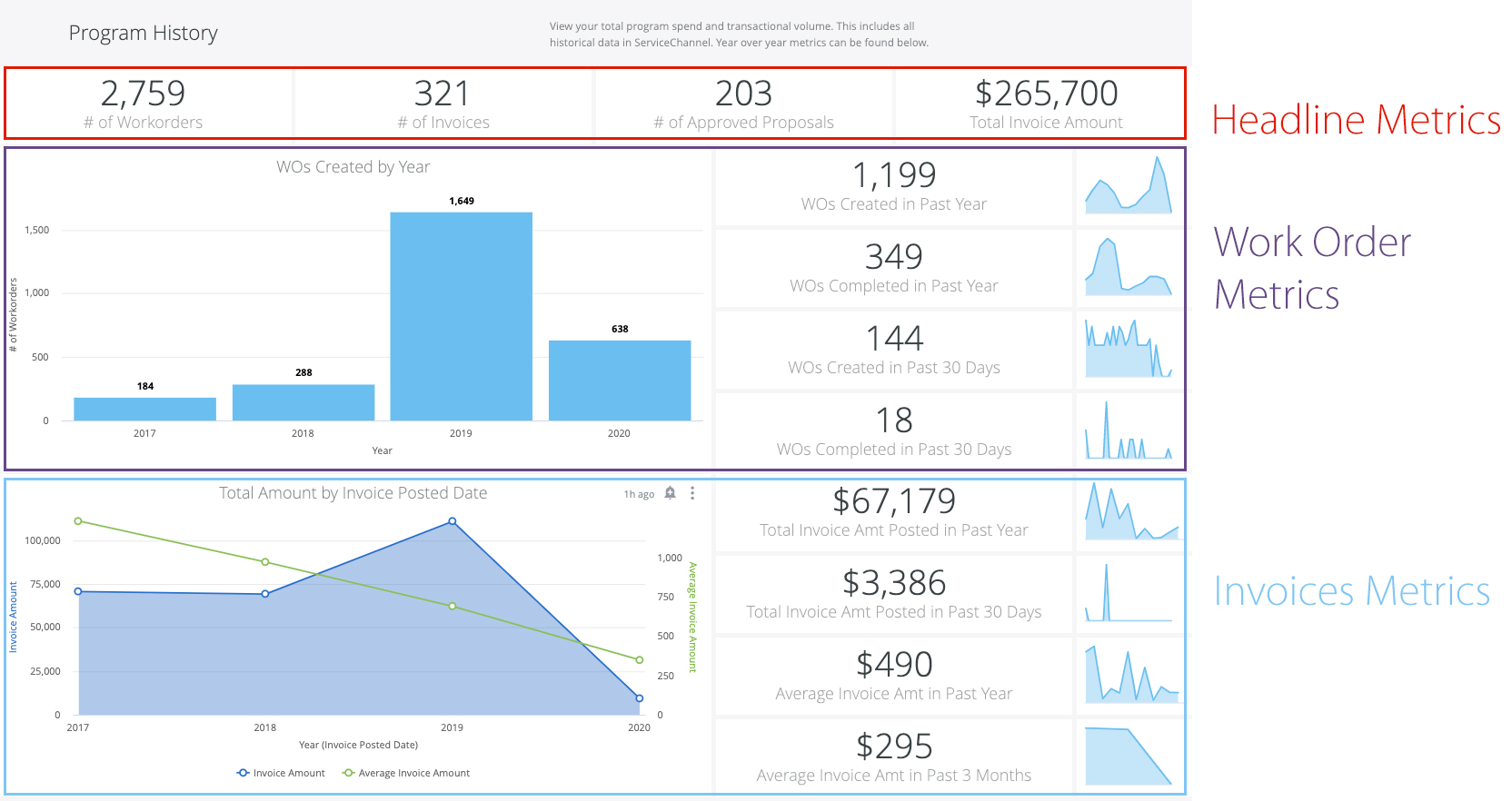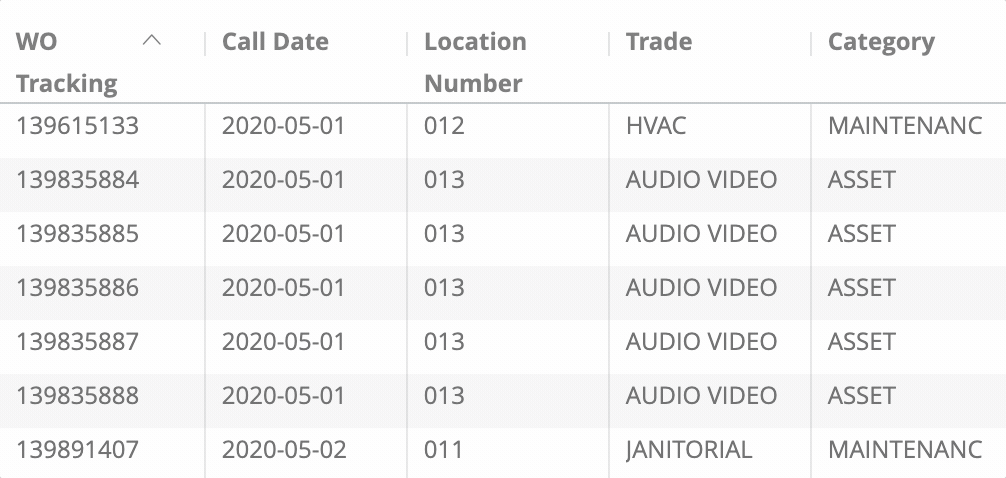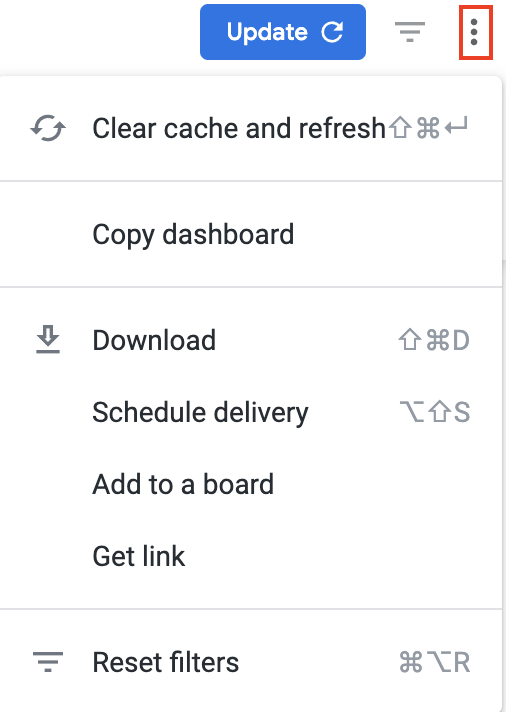Program Overview Tab
Chellie Esters
The Program Overview tab of the Insite dashboard provides historical data on your facility operations across work orders and spend. By reviewing the reports in this tab, you can make key strategic decisions for your facilities operations, such as overall budgeting and financial planning for specific categories or trades.
You will see data for all Trades and Categories (by default) or by the criteria set in the all-inclusive filters along the top of the report.
You can download the data and email reports to recipients.

Visualizations in this Dashboard
The headline metrics are a snapshot of your company's historical data. Here, you will see the metrics # of Workorders, # of Invoices, # of Approved Proposals, and Total Invoice Amount ($).
Both voided work orders and work orders with an empty Status are excluded. Also, years with no work orders are not shown.
- The Work Order Metrics visualizations break down both Created and Completed Work Order volume for specific time frames:
The WOs Created by Year chart shows the number of work orders created, by year. Clicking the chart bars will let you explore tat data point by Region, Feedback, Asset, or Call Date.
Work orders with a call date in the current quarter or prior are included in this chart.
- To the right, you will see the following headline metrics and corresponding visualization trending graphs:
- Work Orders Created in the Past Year
- Work Orders Completed in the Past Year
- Work Orders Created in the Past 30 Days
- Work Orders Completed in the Past 30 Days
- The Invoices Metrics visualizations break down both Total and Average Invoice Amounts posted during specific time frames:
The Total Amount by Invoice Posted Date shows the total invoice amounts per year along with an average invoice trendline. Clicking a data point will let you explore by Asset, District, Trade, or Invoice Posted time frame.
Both voided work orders and work orders with an empty Status are excluded. Also, years with no work orders are not shown.
- To the right, you will see the following headline metrics and corresponding visualization trending graphs:
- Total Invoice Amount Posted in the Past Year
- Total Invoice Amount Posted in the Past 30 Days
- Average Invoice Amount in the Past Year
- Average Invoice Amount in the Past 3 Months
Commonly Used Features
Below is a quick reference guide regarding tracking numbers in Analytics, filtering, sorting, downloading data, and sending reports.
Tracking Numbers in Analytics
Throughout Analytics you can drill down into visualizations to see the underlying data. In most cases, the tracking numbers related to that data are listed. You can click the tracking number to navigate straight to the work order details in Service Automation.
Filtering Dashboards
On top of the report are all-inclusive filters to help you hone in on key data. All reports on the page are affected by the criteria set in these all-inclusive filters.
The filter criteria for each dashboard may differ. Filters reset to the default when the page is refreshed.
Click filter field to show the criteria.

Select the desired criteria to include or exclude:
To Include criteria: select is equal to, contains, starts with, or ends with, and then begin typing the criteria in the picklist. Select the desired criteria (or multiple criteria) from the picklist.
To exclude criteria: select is not equal to, does not contain, does not start with, or does not end with.
Is null depicts the absence of data in a data set. Conversely, is not null depicts the presence of data
To include or exclude data without a certain data criteria — for example, to select data without a Region or District assigned in Service Automation — choose is blank / is not blank.
To add more options, click the plus sign (+) next to a field to add another option to the filter. The new option will appear as either an OR condition or an AND condition, depending on the type of filter option.
Once all criteria are selected, click Refresh icon in the top-right corner. The Dashboard report updates with the selected criteria.
More details are available on Filtering an Analytics Dashboard
Dynamic Table Sorting
Analytics tables are dynamic, as you can:
- click column and row headers to sort data (the arrow indicate which data is sorted),
- hover over a header to show the gear icon where you can interact with the data more dynamically, and
- drag and drop a header to rearrange the table.

Downloading and Sending Reports
In the upper-right corner of any page, click the Vertical Ellipses to download reports, schedule delivery of reports at regular intervals, add to a board, or get a link.

You can download data from a table and visualization or download a dashboard tabto PDF or CSV.
- On the desired table or visualization, hover over the upper-right to expose the 3 dots menu, and then click Download Data. The Download modal appears.

Select the desired File Format and choose a File Name: A default name is listed but you can change it.
- Click Download.
On the desired dashboard (or dashboard tab), click the Gear icon in the upper-right of the page, and then click Download as PDF. The Download modal appears.
A default Filename appears, but you can change it.
Under Advanced options:
Single-column format lays out all tables and visualizations on a page into one column in the PDF, as opposed to how it is laid out in the dashboard.
Expand tables shows all rows in a table, instead of just the rows that appear on the dashboard.
Paper size adjusts the PDF to your desired size.
Click Open in Browser to view the PDF in your chosen browser, or click Download to save a version of the report onto your device.
On the desired dashboard (or dashboard tab), click the Gear icon in the upper-right of the page, and then click Download as CSVs... A new browser tab opens.
After the files render, you are prompted to save the CSV Zip file onto your device.
More details are available on Downloading and Sending Dashboards and Reports
You can also Send a one-time report via email or Schedule a recurring email send.
On the desired dashboard (or dashboard tab), click the Gear icon in the upper-right of the page, and then click Send. The Send (Dashboard Name) modal opens.
A Title is given by default, but you can change it.
Under Who should it be emailed to?, enter the desired recipient(s), separated by a comma, and then click Add.
(Optional) Click Include a custom message to add a personal note.
Under Format data as, choose PDF, Visualization, or CSV Zip file.
(Optional): Click Filters to limit the criteria that appear in the email. Note that the same filters on the dashboard itself will also appear here.
Click Send. The email is sent to your recipients.
On the desired dashboard (or dashboard tab), click the Gear icon in the upper-right of the page, and then click Schedule. The Schedule (Dashboard Name) modal opens.
A Title is given by default, but you can change it.
Under Who should it be emailed to?, enter the desired recipient(s), separated by a comma, and then click Add.
(Optional) Click Include a custom message to add a personal note.
Under Format data as, choose PDF, Visualization, or CSV Zip file.
Under Deliver this schedule, choose Daily, Weekly, Monthly, Hourly, or By minute (in 5-minute increments, up to 30 minutes)
(Optional): Use Filters to limit the criteria that appear in the email. Note that the same filters on the dashboard itself will also appear here.
Click Send. The email is sent to your recipients.
More details are available on Downloading and Sending Dashboards and Reports
-
Page:
-
Page:
-
Page:
-
Page:
-
Page:
-
Page:
-
Page:
-
Page: